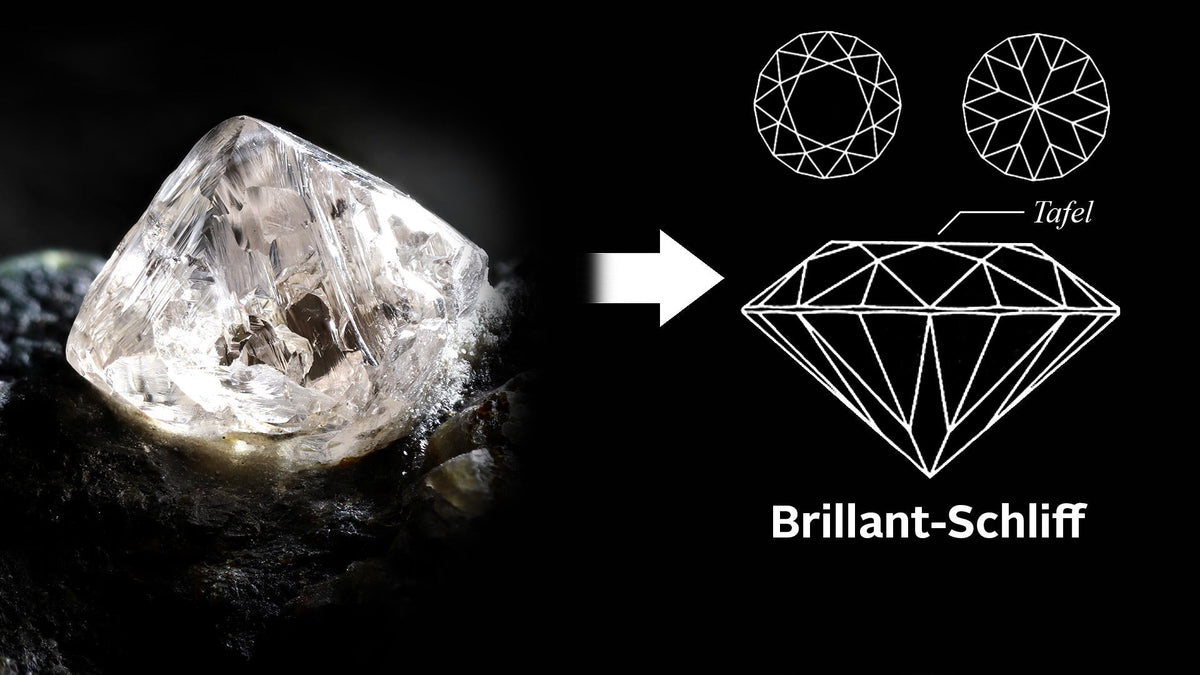

The term "diamond" refers to both the source material and the cut gemstone. Diamonds are made of crystallized carbon and are mined from natural deposits. Once mined, the diamond goes through the process of cutting and polishing to achieve its characteristic shine and brilliance. The original, uncut crystal is the starting point for making jewelry. This fascinating gemstone has a long history as a sought-after piece of jewelry due to its unique physical properties and symbolic meaning.

interesting facts about diamonds
The transformation of a rough diamond into a brilliant is a fascinating process that underlines the extraordinary craftsmanship and precision of the jeweler's art. In its original, natural form, as an uncut crystal, the gemstone cannot develop its full potential of beauty and brilliance. This is where the cut comes into play - an artistic processing that transforms the gemstone into a masterpiece.
There are various types of cut, one of the most well-known of which is the round cut, also known as the brilliant cut. This cut is not only popular, but also particularly effective for optimizing the refraction and reflection of light. Precise processing creates exactly 57 facets that give the gemstone its breathtaking luminosity. Each facet is like a tiny mirror that catches the incoming light and reflects it in an impressive play of colors.
A characteristic feature of the brilliant cut is the "table", the straight "roof" on top of the diamond. This flat surface contributes to the symmetrical arrangement of the facets and forms the window through which the light penetrates the diamond. Only when this complex cutting process is completed - with the precise number of facets and the characteristic table - is the diamond called a brilliant.
The brilliant cut is valued not only for its aesthetic qualities, but also for its ability to bring out the fire and sparkle of a diamond to the maximum. This process requires not only technical expertise, but also a deep connection to the art of jewelry making to transform a raw diamond into a timeless jewel. Therefore, each brilliant is not only a sparkling piece of jewelry, but also the result of careful and artistic craftsmanship.

forms
If a diamond is not cut in the classic brilliant cut, i.e. not round , it is named after the specific cut it has received. In this context, the word "diamond" is always used before the respective cut. This creates different shapes and cuts, such as baguette, heart, square or navette. Naming it after the diamond cut before the specific shape underlines the diversity and uniqueness of the different types of cut, which gives each diamond an individual aesthetic expressiveness in its cut form.

Ring Priscilla
Immerse yourself in the world of luxury jewellery with our unique ring made of 585/- white gold.
This masterpiece of design is flanked by side stones with a total of 0.90 ct. brilliant-cut diamonds in tw/vs quality, while the stunning center stone presents an impressive 5.05 ct. diamond in H/SI1 quality. This piece of jewelry is truly one-of-a-kind and radiates pure elegance and exclusivity. Emphasize your uniqueness and sense of style - order this extraordinary ring today and wear a true masterpiece of jewelry art.
Center stone: 5.05 ct. Diamond H/SI 1
Side stones: 0.90 ct. brilliant tw/vs
facts
Brilliants are the most popular diamonds
The round brilliant shape is by far the most popular cut and is chosen by customers in over 75% of cases. Sizes that are particularly popular are carat weights between 0.5 and 2 carats.
They are among the most valuable and sought-after gemstones for jewelry. Their unique sparkle and brilliance make them the perfect choice for engagement rings, wedding bands and other high-quality jewelry.
The 4 C's: The so-called 4 C's play a decisive role in the evaluation. These include the weight (carat), the color, the clarity and the cut. These factors determine the quality and value of the gemstone.
Cut: The cut of the stone greatly influences its brilliance and shine. There are several different cuts, including the round brilliant cut, the princess cut and the emerald cut, each with different aesthetic properties.
Colors: Colorless or slightly tinted diamonds are usually preferred for jewelry. However, they can come in a variety of colors, from completely colorless to intense shades such as blue, pink or yellow.
Engagement rings: They are one of the most popular choices for engagement rings. The custom of presenting a diamond ring when proposing marriage has a long tradition and symbolizes the eternity of love.
Investment: Some people view diamonds not only as jewelry but also as a long-term investment. High-quality diamonds can increase in value over time.
Certificates: We issue certificates that document the quality of a diamond. These certificates contain information on the 4 C's and allow buyers to verify the quality of the stone.
Heirlooms: Because of their durability and timeless beauty, diamonds are often passed down from generation to generation. They can become valuable heirlooms that preserve family ties and stories.
These facts illustrate the special role of diamonds in the field of jewelry. They are not only sparkling gemstones, but also symbols of love, elegance and timeless beauty.
In summary, a diamond, originally known as a gemstone, goes through a fascinating process of transformation to reveal its full beauty. The cut, especially the popular brilliant cut with exactly 57 facets and characteristic table, is crucial for optimizing light refraction and reflection. This artistic cutting process turns a raw gemstone into a sparkling masterpiece. A diamond is therefore not just a gemstone, but the result of careful craftsmanship that expresses the timeless beauty of this unique mineral.


